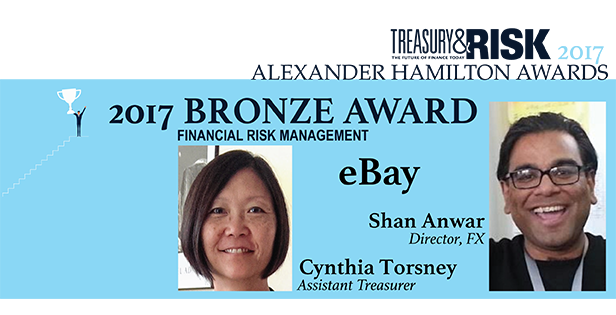 Managing financial risks is a crucial component of corporate treasury's responsibilities. It can also be a highly complex endeavor.
Managing financial risks is a crucial component of corporate treasury's responsibilities. It can also be a highly complex endeavor.
As the global political climate becomes increasingly unpredictable, the pressure mounts for treasurers of multinationals to contain the risks posed by volatility in currencies and in global debt and equity markets. Some treasury teams are struggling under the increased attention. For others, the spotlight of scrutiny has become a place to shine. In this second category are the winners of the 2017 Alexander Hamilton Awards in Financial Risk Management. These treasury groups have developed innovative solutions for mitigating financial risks, and then developed cross-functional programs to successfully implement those ideas.
One of these award-winning companies, global telecom provider Ericsson does business in 180 countries and 109 currencies. The truly global scope of the company makes visibility into foreign exchange (FX) exposures absolutely business-critical. However, the company's legacy process for managing currency risks involved a great deal of manual data entry, which was both time-consuming and error-prone.
Recommended For You
Seeing an opportunity for improvement, Ericsson automated the collection and aggregation of currency exposure data. The project simultaneously saved 120 hours per month for treasury staff and reduced the company's volume of external hedges by more than 40 percent, saving more than US$2 million a year. Most important, Ericsson gained better visibility into its FX risks than it had ever previously achieved. Treasury managers are now able to make better, more informed hedging decisions. In some instances, they have even discovered risks of which they were previously unaware.
For eBay, spinning off PayPal in 2015 essentially split the company in half. The divestiture radically changed eBay's risk profile in a number of ways, not least of which was its exposure to movements in global currencies. Many of the natural hedges the combined company had enjoyed disappeared for the separated entity. The exposures were significant, especially for the company's euro-functional subsidiary, so management charged the treasury team with finding a way to get mark-to-market for euro–dollar moves off the eBay P&L.
The initiative proved highly complex, but by pulling together a cross-functional team that included all the affected departments, treasury came up with a two-step process for mitigating euro–dollar exposures that accomplished everything eBay management required. Involving the right individuals, from the right functions, from the beginning of the project was key to its success, according to Cynthia Torsney, assistant treasurer of eBay. "You need to make sure that you identify all the stakeholders," she says, "and that each of them understands what the objective is and what needs to get done."
For captive auto-financing company Toyota Financial Services (TFS), maintaining consistent and reliable access to liquidity is a fundamental business need. When the Formosa bond market in Taiwan opened to foreign issuers in 2014, TFS saw a great opportunity to tap a new source of funding that wouldn't cannibalize any of the company's existing debt. However, entering the Formosa bond market proved challenging. To close the duration gap between the "30 non-call 5" Formosa bonds and TFS's auto loan and lease portfolio, the company paired its bond issue with a derivative. Managing the callable debt and the associated derivatives required modifications to treasury systems and to the company's valuation methodology.
 The initiative was worth the effort. "In August 2015, we issued US$750 million of 30-year non-call 5-year fixed-rate senior notes in the Formosa bond market," says Stephanie Wang, manager of debt and derivatives at Toyota Financial Services. "This was at a time when China's equity markets were blowing up and our primary markets were essentially shut down due to severe market stress. But because of all the legwork we had done to prepare, we were able to issue this bond to a very specific investor base that wasn't affected by this market volatility in the background."
The initiative was worth the effort. "In August 2015, we issued US$750 million of 30-year non-call 5-year fixed-rate senior notes in the Formosa bond market," says Stephanie Wang, manager of debt and derivatives at Toyota Financial Services. "This was at a time when China's equity markets were blowing up and our primary markets were essentially shut down due to severe market stress. But because of all the legwork we had done to prepare, we were able to issue this bond to a very specific investor base that wasn't affected by this market volatility in the background."
Congratulations to all three of this year's winning companies! Read on to learn about their adventures—and great successes—in financial risk management.

Doing the FX Two-Step to Optimize Corporate Hedging Strategy
When eBay spun off PayPal in 2015, its business was transformed overnight. Not only was the new entity half the size of the former combined organization, but it had a radically different risk profile. This was especially noticeable in the realm of FX.
"When we were a combined company, eBay was able to use PayPal exposures to hedge at a consolidated level," says Cynthia Torsney, assistant treasurer of eBay. "When we separated, we lost the ability to use those exposures." About 60 percent of the new company's sales are generated outside the United States, making currency risk a major concern.
The obvious solution, hedging, presented a challenge. Most of the company's exposures in euros and pounds sterling—two of its top three currencies outside the U.S. dollar—flow through a euro-functional subsidiary. Although the subsidiary can use hedge accounting for derivatives that translate risk from other currencies into euros, it cannot use hedge accounting on dollar-denominated trades. Because parent company eBay Inc. is dollar-functional, euro exposures are risks to its P&L.
"The main point of hedge accounting is to make sure that FX shifts are associated with the correct timing on your P&L," Torsney says. "You jump through all those hoops so that the mark-to-market of the derivative isn't flowing through your P&L every month. Once we decided to separate eBay and PayPal, we had to come up with a plan where we were able to get the correct timing in terms of when hedges show up on the P&L."
eBay treasury had three options. The first was to just not hedge currency risks. "We could have let the underlying exposure translate at the prevailing rates in each time period," says Shan Anwar, director of FX. "But we dismissed that out of hand. FX risk is a huge exposure for us, so we had to figure out a way to hedge it."
Option two was to hedge all the company's currency risks into dollars, but not bother with hedge accounting. "But then we would have a timing mismatch," Anwar explains, "because the unrealized mark would hit our P&L in the interim. The company didn't want to take on the unrealized mark-to-market effect."
Instead of settling for either of these options, eBay treasury set out to find an alternative that would mitigate the company's risk and qualify for hedge accounting treatment. Members of the capital markets, cash, and investments groups spearheaded a cross-functional team that also included tax and technical accounting staff, to make sure options under consideration would actually deliver the desired benefits for corporate reporting.
The cross-functional team settled on a two-step process in which the euro-functional subsidiary hedges all its currency risks using euro-denominated forwards, and then eBay Inc. purchases dollar-denominated securities of the same duration as the hedging instruments.
As an example, suppose the euro-functional subsidiary has a forecasted exposure of GBP 1,000 that is expected to realize in six months. The company's first step in mitigating this risk is for the subsidiary to execute a standard hedge that sells forward the GBP 1,000 and buys euros—say, EUR 1,150. This transaction converts the forward pound exposure into a euro exposure, and it qualifies for hedge accounting on the books of the subsidiary. However, the transaction doesn't solve the problem of currency exposure for the USD-denominated parent company.
Thus, the second step of the process is for the eBay investments team to buy a security that will deliver U.S. dollars equivalent to the euro exposure at the prevailing exchange rate, and deliver them at same time the forward hedge matures. "In this example, we'll look at the EUR 1,150 that we know we'll receive in six months, and we'll spot that amount to U.S. dollars today," Anwar explains. If EUR 1,150 is currently equivalent to USD 1,250, then "with the cash we now have in hand, our investments team will go out and buy highly rated securities, per our investments policy, in the notional amount of USD 1,250 and with a tenor of six months."
eBay Inc. will record the unrealized mark-to-market on the euro–pound forward to an equity account, Other Comprehensive Income (OCI), because it qualifies for hedge accounting. And it will designate the 1,250 in USD securities as Available for Sale (AFS), which requires the security to be fair-valued but with the changes in fair value reflected in OCI. This designation enables the company to record changes in euro–dollar rates on the the balance sheet, as well.
Six months later, at maturity of the euro–pound forward, the realized mark-to-market hits the eBay Inc. P&L. The USD-denominated investments mature at the same time, so the amounts being held in OCI are simultaneously released to the eBay Inc. P&L.
 "So we get the timing of the underlying exposure, the derivative, and the security all at once," Anwar says. This approach proved enormously valuable when the pound sterling dropped following last summer's Brexit vote. "We've mitigated much of Brexit's impact on our business," Anwar says. Adds Torsney: "Senior management was quite happy that we were able to hedge with this new program prior to Brexit."
"So we get the timing of the underlying exposure, the derivative, and the security all at once," Anwar says. This approach proved enormously valuable when the pound sterling dropped following last summer's Brexit vote. "We've mitigated much of Brexit's impact on our business," Anwar says. Adds Torsney: "Senior management was quite happy that we were able to hedge with this new program prior to Brexit."
Torsney credits much of the project's success to the inclusion, from the beginning, of individuals from accounting, tax, capital markets, investments, and cash management. "There was a lot of discussion around which entity should book these securities, and it was absolutely crucial that we get that right," she says. "We also needed the capital markets and investments teams to buy in to the project because they would be responsible for purchasing the securities. And we needed the cash management team fully on board because they had to make sure we had enough cash to buy the securities. Everybody had to basically sign on the dotted line and agree that they understood the risks and the rewards, and wanted to move forward."
eBay's treasury function achieved the requisite buy-in through a very clear, intentional communication strategy. The team first broached the idea with the company's CFO and other C-level executives on eBay's standing Capital Markets Review Committee. "Treasury has built trust with this committee by regularly explaining capital-market issues," Torsney says. "Because they already trusted us, when we presented this currency hedging strategy at a 30,000-foot level, they gave us the authority to move forward."
Communication was also crucial within the cross-functional project team. "It's important to remember in projects like this that the treasury components, especially around hedging and derivatives, can get fairly complicated," Anwar says. "As you're pulling in stakeholders from other functions, you have to be patient. Some of the details that you may know inside out, because you deal with them every day, may not be as obvious to people in accounting or tax. Educating those stakeholders about the intricacies of your project, and about why your project is important, may be key to earning their support and help with the initiative."

When Visibility into FX Exposures Is Business-Critical
Few companies are as truly global as Telefonaktiebolaget LM Ericsson. The telecommunications infrastructure giant has operations in more than 180 countries, and it does business in 109 currencies.
"To keep our margins stable, it is imperative that we have a currency risk management structure that gives us visibility into areas where currency risks cancel each other out organically, as well as areas where we need to engage in FX transactions to mitigate risks," says Magnus Attoff, head of financial risk management and internal bank for Ericsson.
Several years ago, the company's approach to managing currency risk was suboptimal, to say the least. "For the 30 Ericsson entities that had the largest exposures, a shared-service center would manually extract FX risk data from our ERP system, account by account," Attoff says. "If anything seemed strange, they would go back to the business with questions. And once they felt they had a handle on the entity's FX situation, they would hedge any exposures over US$3 million."
Not only was this process time-consuming, but the manual data extraction and data entry sometimes resulted in errors. It also separated FX risk management decisions from the business units generating those exposures. "The people who were extracting the information didn't know anything about the risks," Attoff says. "They did not feel responsibility for the numbers that they were reporting. So there was no clear ownership of FX risks, nor of the results that FX risk management activities generated."
Seeing an opportunity for substantial savings of both time and money, Ericsson's treasury team launched a ground-up redesign of the company's currency risk management program. The project had three related goals: first, to reduce the impact of FX on the company's P&L by giving team members better information about currency exposures; second, to improve efficiency enough that those team members could undertake more value-added activities, such as forecasting future FX risks and investigating discrepancies; and third, to reduce hedging costs by eliminating external hedges wherever the company already had a natural hedge in place.
The company's initial plan for achieving these goals was to have the corporate treasury, accounting, and IT functions work together to develop a system that would extract exposure data from SAP and validate its accuracy. When the project hit roadblocks, the project team reconsidered this approach.
"When our original plan was not successful, we quickly changed plans," Attoff says. "We decided to collaborate with an outside vendor to implement a third-party platform that would extract, validate, and distribute our exposure data." Ericsson selected FiREapps to fill that role.
Rollout of the software was iterative, and again the project team demonstrated the value of agility. Nowhere was this clearer than in the decision about how much to centralize the gathering of, and reporting on, risk data. "We were balancing competing objectives: Decentralizing would push out more of the currency risk management processes to the business units generating those risks, which we wanted to do, while centralizing could improve efficiency in execution of risk management decisions," Attoff says.
"We started with 21 regional hubs around the world for the consolidation and reporting of FX exposure data," Attoff says. "But we realized that as the FX risk managers' jobs shifted from simply compiling data to analyzing it, we needed for their expertise to be more specialized. It made sense to consolidate the hubs to gain more of a critical mass of expertise in each of them." Over the course of three years, Ericsson reduced the number of regional hubs from 21 to 14, and then subsequently to five.
Today the cloud-based FX exposure management system sits atop a treasury management system, single-bank and multibank FX trading stations, and market analytics portals. Because the information is automatically pulled into this system, Ericsson has eliminated many of the error-prone steps in its legacy process and has reduced the amount of staff time spent on FX data management by 120 hours per month. The company has also reduced external hedges by more than 40 percent, cutting costs more than US$2 million per year.
 Perhaps most important, the company's FX hedgers now get information much faster. "We have a single-rate environment," Attoff explains, "so every month we have one rate for each currency pair, and that rate is set on the last day of the month. The farther away from the end of the month we make our FX trades, the less likely the hedge information is to still be accurate, and so the less effective the hedges may be. Before, our risk managers got FX information six days after the end of each month. This project reduced that to four days, and we're hoping to get it down to three in the near future."
Perhaps most important, the company's FX hedgers now get information much faster. "We have a single-rate environment," Attoff explains, "so every month we have one rate for each currency pair, and that rate is set on the last day of the month. The farther away from the end of the month we make our FX trades, the less likely the hedge information is to still be accurate, and so the less effective the hedges may be. Before, our risk managers got FX information six days after the end of each month. This project reduced that to four days, and we're hoping to get it down to three in the near future."
The improved FX exposure data has brought to light some surprising revelations. In one large country, risk managers previously thought that their accounts payable balance was offset by receivables, so they were minimizing hedges. "We evaluate all our hubs based on the impact FX has on their businesses' P&L," Attoff says. "If we had perfect hedging, this number would always be zero. But in this case, the FX impact was not zero. When the team dug into what was going on, they realized that although the payable was a liability that was truly payable in dollars, the receivable was a non-deliverable forward, and the rate our customer would pay when it was due would not be the same rate as we used for the payable. They weren't equivalent after all, so we discovered an exposure that we didn't know we had."
Attoff attributes the initiative's success to two project management decisions. The first was Ericsson's decision to roll out the new exposure-management technology first, and delay people and process changes until the software was functional. "People are slower, and processes are slower," he says. "IT changes might be more expensive, but you can make them more quickly. If you can roll them out first and show the benefits of change, you're going to make a more successful business case for the people and process side of the project."
The other key to success was the willingness of Ericsson treasury to change course when their initial plans weren't working. "It's difficult, but also very important, to constantly learn throughout the course of a project," Attoff says. "You can't assume that you will get all the answers right up front. There are always things you don't know when you are just starting out. When you undertake a big initiative like this, you have to acknowledge when plans aren't working. And rather than getting discouraged, you have to be willing to adapt your project plan as you learn."

Cross-Functional Attack on Liquidity Risks
Without reliable sources of cash, Toyota Financial Services (TFS) has no business. As the captive finance arm of Toyota Motor Corp., the company's mandate is to support the sales of Toyota and Lexus vehicles. TFS borrows money in the debt capital markets and then lends that money, through auto loans and leases, to buyers of Toyota and Lexus vehicles in the United States.
"We're one of the largest captive finance companies out there," says Bill Pang, manager of debt capital markets for Toyota Financial Services. "Our balance sheet is in excess of $100 billion right now, and we need to raise between $25 billion and $30 billion of funding every year to support business needs and refinance existing debt. We work hard to make sure we're always in a position to have adequate funds available to our business."
One key to managing business-critical liquidity risks is to build agility into funding processes, Pang says. "We want to make sure we give ourselves as much flexibility as possible when it comes to planning the funding. One aspect of that is to have a diverse investor base and to issue in diverse markets."
In June 2014, a new market opened to companies like Toyota Financial Services: the Formosa bond market in Taiwan. Previously, only a small portion of funds in that market could be invested in securities denominated in a foreign currency. But in June 2014, regulatory changes allowed Formosa bonds to be denominated in foreign currencies and still qualify as domestic investments. The market was dominated by issuances from global banks, but also presented new opportunities for corporate issuers.
For Toyota Financial Services, this change generated an important new option for liquidity. "The Formosa market was very attractive to us because the investors there do not overlap or cannibalize any of the demand that we already had in our other U.S. dollar products," Pang says. "It was a truly diversified source of funding for us. And given the depth of that market, it was one we knew we should prepare to access."
The Formosa market offered a 30-year bond with a non-call five-year period, but to avoid a significant mismatch between assets and liabilities on its balance sheet, Toyota Financial Services needed to pair this bond with a derivative.
 "In an ideal world, of course, we would match the duration of our assets exactly to our liabilities," Pang says. "With the Formosa bonds, we have the option to call the note back in the fifth year, and then annually thereafter. But the average life of a '30 non-call 5' is around 10 years, and theoretically the note could last 30 years. In contrast, the weighted-average duration of our loan and lease portfolio is around two to two-and-a-half years."
"In an ideal world, of course, we would match the duration of our assets exactly to our liabilities," Pang says. "With the Formosa bonds, we have the option to call the note back in the fifth year, and then annually thereafter. But the average life of a '30 non-call 5' is around 10 years, and theoretically the note could last 30 years. In contrast, the weighted-average duration of our loan and lease portfolio is around two to two-and-a-half years."
The solution to the duration mismatch was to swap the 30-year callable debt back to a floating-rate three-month dollar LIBOR equivalent. "What we ended up doing is monetizing the call option that's embedded in the note," Pang says. "By selling that option on a swap, we are able to lower our cost of funds. We pay quarterly three-month LIBOR plus a spread after we've monetized the option, and in return we receive the coupon payment that is due to the investor from our swap counterparty."
Before the company could execute this complex debt strategy, it had to make significant changes to both treasury processes and systems. Toyota Financial Services' debt and capital markets group convened a cross-functional team to begin preparing for a Formosa bond issue.
"We realized that a lot of business groups would need to be involved," explains Stephanie Wang, manager of debt and derivatives. "Groups from operations to systems to legal, as well as our accounting and valuations teams, all needed to be involved from the beginning. We held regular meetings to encourage collaboration and so that everyone would understand the vast scope of the project and stay current on what the different project groups were working on."
The debt capital markets team partnered with the structuring agent on execution. The treasury operations team studied Taipei listing requirements and prepared to execute Formosa bonds. The legal team worked on building a new settlement capability, since the bonds would need to settle through Euroclear or Clearstream. Legal also took responsibility for the vast quantity of documentation that the Taipei listing and Formosa issue would require. Meanwhile, the accounting team worked to determine how to properly record the transaction.
One area of the preparations that proved particularly complex was determining the bond's fair value on a daily basis for collateral purposes, as well as at month-end and quarter-end for reporting purposes. "Establishing the present value of each of those call options in years 5 through 30 becomes murkier and murkier the farther out you go," Pang says. "It's because those particular options are not traded frequently, particularly that far out on the curve. And even some of the inputs required us to make certain assumptions before we could get to a reasonable valuation."
Toyota Financial Services' valuation team partnered with an outside consulting firm to develop an effective valuation methodology for the Formosa note's call options. Their efforts underpinned the success of the entire initiative.
"Our goal is to eventually have the ability to value any bond or derivative in our portfolio," Pang says. "To an extent, the callable bond was much more challenging than most, and we were testing our limits in terms of what we are capable of valuing." Nevertheless, the benefits of undertaking such a complex valuation project will extend far beyond TFS's first Formosa bond issue. "We see building out this capability as an investment in our company and in our future," Pang says.
Once Toyota Financial Services had established its valuation methodology, the accounting team took the lead in educating the company's auditors and gaining their buy-in. And the debt capital markets group worked with systems teams to ensure that the company's treasury management system would accurately book these transactions.
"We needed to make sure the systems would correctly project and value the cash flows," Pang explains. "We also wanted to ensure they were capable of handling the call option that is embedded in these notes, as well as in the associated swaps."
Together, the cross-functional team built a solid infrastructure for handling this unusual debt issuance. "In the treasury department at Toyota Financial Services, we emphasize the importance of working collaboratively together, and this project is a great example of that," Wang says. "It also exemplifies the Toyota principle of kaizen, or continuous improvement. The company encourages us all to challenge ourselves on an ongoing basis to find opportunities for improvement and innovation."
The results have been tangible, opening an entirely new market in which Toyota Financial Services can issue debt. "In August 2015, we issued US$750 million of 30-year non-call 5-year fixed-rate senior notes in the Formosa bond market," Wang says. "This was at a time when China's equity markets were blowing up and our primary markets were essentially shut down due to severe market stress. But because of all the legwork we had done to prepare, we were able to issue this bond to a very specific investor base that wasn't affected by this market volatility in the background."
"Being able to access the Formosa bond market provides us a new, truly diversified source of funding," Pang adds. "Because this market is effectively insulated from other investors whom we would normally cater to with our benchmark transactions, it's a very valuable addition to our portfolio."
© 2025 ALM Global, LLC, All Rights Reserved. Request academic re-use from www.copyright.com. All other uses, submit a request to [email protected]. For more information visit Asset & Logo Licensing.




